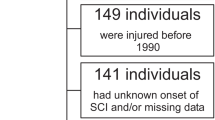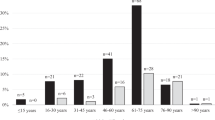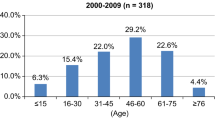Abstract
Study design:
Register survey.
Objective:
To provide national Finnish data on the incidence of traumatic spinal cord injury (TSCI) over a 30-year period.
Setting:
Käpylä Rehabilitation Centre, Helsinki, Finland.
Methods:
Patients aged 16 years and older who sustained a TSCI between 1976 and 2005 were identified using the registers of the Käpylä Rehabilitation Centre.
Results:
The medical records of a total of 1647 patients (1362 men and 285 women) were analyzed. The mean annual incidence rate for the entire population was 13.8/1 000 000. Age-adjusted incidence did not change among men or women during the three decades, but the mean age at injury of both men (from 34.7 to 42.4 years) and women (from 35.8 to 40.4 years) increased. The annual incidence of new TSCI rose significantly in persons 55 years and older. The proportion of tetraplegia and of incomplete injuries increased, too.
Conclusion:
Although TSCI is predominantly present in young men, more attention for primary prevention, medical care and rehabilitation in men and women aged 55 years and older is needed. An international uniformity in methodology to collect epidemiological data of TSCI is needed.
Similar content being viewed by others
Introduction
Estimates of the incidence and prevalence of spinal cord injury (SCI) have received attention because of the great impact of this injury in social, economic and personal terms. For planning of preventive clinical and community services, appropriate epidemiological data are essential.1 Incidence studies abound but only a few prevalence studies have been published.2, 3 However, most of the incidence studies have very short observation periods.4 In recent years, incidence reports with observation periods of 10 years or more have been rather uncommon.5, 6, 7
Finland is situated in the northern part of Europe. Its population is about 5.2 million and its area 338 000 square kilometres (Figure 1).
Two reports in Finland have provided prevalence data on traumatic spinal cord injury (TSCI), but neither international nor national reports of incidence exist.2, 8
The aim of this study was to gather national Finnish data on the incidence of TSCI and to outline the typical features as age, gender, external causes and neurological level and extent over a 30-year period.
Materials and methods
The Käpylä Rehabilitation Centre was established in 1953, mainly to rehabilitate victims of polio epidemics, but also to rehabilitate persons with SCIs. Acute care of fractures and other traumas of the spinal column with or without neurological deficits take place in regional central hospitals.
Since the 1960s, Käpylä Rehabilitation Centre has been the only national rehabilitation centre in Finland to care for patients with SCI immediately after the acute hospital phase. This is in accordance with the official recommendation of the Ministry of Social Affairs and Health of Finland.
Cases aged 16 years and older who had sustained TSCI between 1976 and 2005 were identified using the registers of the Käpylä Rehabilitation Centre. The numbers of different age and gender groups were obtained from the Official Statistics of Finland.9
ICD-9 (International Statistical Classification of Diseases and Related Health Problems) diagnosis codes 806, 952 and 9072A were used until 1995. ICD-10 was introduced in Finland in 1996, and diagnosis codes S14–S34 were used thereafter.
The definitions of complete and incomplete injury were derived from Maynard et al.10
Statistical methods
Patients with TSCI and the general population aged 16 years and over were stratified by sex and age (16–24, 25–34, 35–44, 45–54, 55–64 and over 64 years), and TSCI incidence rates with 95% confidence intervals (CIs) were calculated using Poisson distribution. Standardized estimates of TSCI incidence rate and incidence rate ratios were calculated by using Poisson regression models. Statistical significance for linearity was evaluated by analysis of variance.
The study protocol was approved by the ethical committee of the Käpylä Rehabilitation Centre.
Results
The data of 1647 TSCI patients (1362 men and 285 women) aged 16 years and over were analyzed. The mean annual incidence rate for the entire population was 13.8/1 000 000 persons, for men 23.8/1 000 000 and for women 4.6/1 000 000 (Figure 2). Age-adjusted incidence rates did not change among men or women during the three decades. The age-adjusted incidence rate ratio (IRR) between men and women was 4.9 (95% CI 4.3–5.6).
The mean age at onset of injury increased among both men (from 34.7 to 42.4 years; p for linearity <0.001) and women (from 35.8 to 40.4 years; p for linearity 0.047) over the three decades (Table 1).
Among men and women aged 55 years and older, the incidence rate per million person-years was significantly higher in 1996–2005 than in 1976–1985. The IRR for men was 2.2 (95% CI 1.6–3.2) and for women 2.4 (95% CI 1.0–5.7). No significant changes occurred in the other age groups (Figure 3).
The external cause of injury was fall in 41.2%, traffic in 39.5%, diving in 6.6%, violence in 2.7% and others in 10.0% of cases. The proportion of injuries due to falls increased over time in persons 55 years and older (men: IRR=2.5 (95% CI 1.6–4.1) and women: IRR=2.6 (95% CI 0.8–11.1)). (Figure 4).
Over the entire three decades, 50.6% of cases had tetraplegia and 49.4% paraplegia (Table 2). During the last decade, the proportion of tetraplegia rose. However, in both tetraplegia and paraplegia subgroups, incompleteness of injury was more common during the last decade than before.
Discussion
Our study clarified the incidence and the national trends of TSCI patients in Finland over a 30-year period. The observation by Wyndaele and Wyndaele4 that during recent years a higher percentage of SCI patients are tetraplegics, is in line with our study. We especially found an increase in incomplete cervical injuries. Moreover, increasing age at injury of SCI patients was noted, a finding also reported on other continents.6, 7
Data comparison in Nordic countries reveals, that TSCI incidence in Finland is similar than that in neighbouring countries: below 20/1 000 000 people. Falls as a cause of SCI are more common in Finland than in other Nordic countries.11, 12, 13, 14 Typically, in Finland and in other Nordic countries, violence is an uncommon cause of SCI as compared with USA.6
This study has some limitations. Firstly, the focus was on TSCI survivors. Persons who died before they arrived at hospital or who died in the acute hospital phase were not included. However, some elderly or otherwise severely injured patients are likely not referred to the Käpylä Rehabilitation Centre. Thus, the incidence (13.8/1 000 000 persons) reported here is probably somewhat underestimated.
Secondly, this study excluded patients aged under 16 years because paediatric SCIs are rare in Finland and not regularly attended to by the Käpylä Rehabilitation Centre. Rehabilitation of these paediatric patients occurs in regional university hospitals, in the neuropaediatric department.15 Our study therefore included population-based frequencies only for individuals aged 16 years and older. The incidence reported here would have been overestimated, had this study also included persons younger than 16 years, because this is a relatively large subgroup.
Finally, we suggest that items of international incidence reports should at least include: data from a defined geographical area, both absolute and population-based frequencies, age, gender, neurological level and completeness of injury, a clear discrimination between traumatic and non-traumatic cases and the external cause leading to SCI. Comparing epidemiological studies of SCIs and correlating the results are problematic because of the lack of international uniformity in methodology and data collection. Incidence data are always valuable, but data collection over longer periods should be encouraged to better reveal trends.
References
Blumer CE, Quine S . Prevalence of spinal cord injury: an international comparison. Neuroepidemiology 1995; 14: 258–268.
Dahlberg A, Kotila M, Leppänen P, Alaranta H . Prevalence of spinal cord injury in Helsinki. Spinal Cord 2005; 43: 47–50.
ÓConnor PJ . Prevalence of spinal cord injury in Australia. Spinal Cord 2005a; 43: 42–46.
Wyndaele M, Wyndaele J-J . Incidence, prevalence and epidemiology of spinal cord injury: what learns a worldwide literature survey? Spinal Cord 2006; 44: 523–529.
Maharaj JC . Epidemiology of spinal cord paralysis in Fiji:1985–1994. Spinal Cord 1996; 34: 549–559.
Nobunaga AI, Ko BK, Karunas RB . Recent demographic and injury trends in people served by the model spinal injury care systems. Arch Phys Med Rehabil 1999; 80: 1372–1382.
ÓConnor PJ . Forecasting of spinal spinal cord injury annual case numbers in Australia. Arch Phys Med Rehabil 2005b; 86: 48–51.
Saikkonen J, Karppi P, Huusko TM, Dahlberg A, Mäkinen J, Uutela T . Life situation of spinal cord-injured persons in Central Finland. Spinal Cord 2004; 42: 459–465.
Statistics Finland. www.tilastokeskus.fi.
Maynard FM, Bracken MB, Creasey G, Ditunno JF, Donovan WH, Ducker T et al. International standards for neurological and functional classification of spinal cord injury. Spinal Cord 1997; 35: 266–274.
Biering-Sörensen F, Pedersen V, Clausen S . Epidemiology of spinal cord lesions in Denmark. Paraplegia 1990; 28: 105–118.
Knutsdottir S . Spinal cord injuries in Iceland 1973–1989. A follow up study. Paraplegia 1993; 31: 68–72.
Levi R . The Stockholm Spinal Cord Injury Study: medical, economical and psycho-social outcomes in a prevalence population. Doctoral dissertation. Karolinska Institute: Stockholm, 1996.
Hjeltnes N . Incidence of Norwegian SCI Patients. Personal communication, 2007.
Kannisto M . Pediatric spinal cord injury, years after the lesions. Ph D thesis, Hospital for Children and Adolescents. University of Helsinki: Finland, Helsinki, 1999, p109.
Author information
Authors and Affiliations
Corresponding author
Rights and permissions
About this article
Cite this article
Ahoniemi, E., Alaranta, H., Hokkinen, EM. et al. Incidence of traumatic spinal cord injuries in Finland over a 30-year period. Spinal Cord 46, 781–784 (2008). https://doi.org/10.1038/sc.2008.53
Received:
Revised:
Accepted:
Published:
Issue Date:
DOI: https://doi.org/10.1038/sc.2008.53
Keywords
This article is cited by
-
Temporal changes in demographic and injury characteristics of traumatic spinal cord injuries in Nordic countries - a systematic review with meta-analysis
Spinal Cord (2022)
-
Epidemiology of traumatic spinal cord injury in Finland
Spinal Cord (2021)
-
Incidence of adult traumatic spinal cord injury in Saint Petersburg, Russia
Spinal Cord (2019)
-
Change in the profile of traumatic spinal cord injury over 15 years in Spain
Scandinavian Journal of Trauma, Resuscitation and Emergency Medicine (2018)
-
Epidemiology of spinal fractures and associated spinal cord injuries in Iceland
Spinal Cord Series and Cases (2018)







